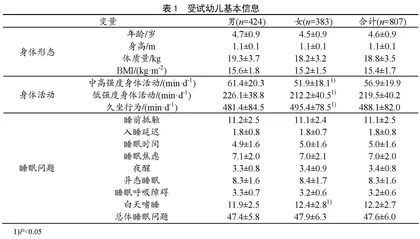基于等时替代模型的幼儿身体活动、久坐与睡眠的关系
作者: 胡学文 赵广高 付近梅 苏利强 孙顺利 陈睿铭 陈德龙 蒋天乐 李雨浓 沈凡超

摘 要:探讨采用等时替代模型模拟中高强度身体活动、低强度身体活动、久坐行为相互替代后幼儿睡眠问题的变化特征,总结不同类型学龄前儿童睡眠问题改善的有效策略。募集9所幼儿园3~6岁幼儿807名,借助三轴加速度计测量身体活动与久坐行为,通过儿童睡眠习惯问卷评估幼儿总体及8个维度睡眠问题,使用63种线性回归模型评估不同强度身体活动、久坐行为与幼儿总体及各维度睡眠问题之间的关系,在此基础上分别评估达标与未达标幼儿中高强度身体活动等时替代低强度身体活动、久坐行为后幼儿总体及各维度睡眠问题的变化。结果发现,中高强度身体活动对幼儿总体睡眠问题及睡眠时间、白天嗜睡等维度具有显著负向作用,同时中高强度身体活动以10 min等时替代低强度身体活动、久坐行为时,全部与未达标幼儿总体睡眠问题均显著下降且均随替代时间的增加而持续下降。在各维度中,中高强度身体活动以10 min等时替代低强度身体活动、久坐行为时全部与达标幼儿睡眠时间均显著下降,未达标幼儿异态睡眠、白天嗜睡均显著下降。此外,等时替代久坐行为时全部幼儿入睡延迟、白天嗜睡均显著下降。研究认为,提升中高强度身体活动水平有利于幼儿保持充足睡眠和缓解白天嗜睡,进而改善幼儿睡眠问题。当幼儿活动时间不变,增加其中高强度身体活动相对比例并相应地减少低强度身体活动或久坐行为比例,是解决幼儿尤其是未达标幼儿睡眠问题的有效策略。此外,以中高强度身体活动等时替代低强度身体活动或久坐行为,可针对性地改善达标或未达标幼儿某一个或几个维度的睡眠问题。
关 键 词:幼儿身体活动;久坐;睡眠;等时替代模型
中图分类号:G807.1 文献标志码:A 文章编号:1006-7116(2024)05-0143-08
The relationship between physical activity, sedentary behavior and sleep in
young children based on the isochronic substitution model
Abstract: To explore the changing characteristics of young children's sleep problems after using the isochronic substitution model to simulate the mutual substitution of moderate to vigorous intensity physical activity, light intensity physical activity, and sedentary behavior, and then summarize the effective strategies for improvement of different types of preschool children's sleep problems. 807 children aged 3 ~ 6 years old from 9 kindergartens were recruited, 63 linear regression models were used to evaluate the relationship between different intensity physical activity, sedentary behavior and children's overall and various dimensions of sleep problems. On this basis, the changes of children's overall and various dimensions of sleep problems after moderate to vigorous physical activity replaced light physical activity and sedentary behavior were also evaluated, respectively. The results showed that moderate to vigorous intensity physical activity had significant negative effects on sleep problems, sleep duration, daytime sleepiness and other dimensions, and that when moderate to vigorous intensity physical activity replaced light intensity physical activity and sedentary behavior with 10 min isochronous time, the total sleep problems of all and substandard children decreased significantly, and all of them continued to decrease with the increase of replacement time. In each dimension, when moderate to vigorous intensity physical activity replaced light intensity physical activity and sedentary behavior with 10 min isochronous time, sleep duration of all children with the standard was significantly decreased, while parasomnias and daytime sleepiness of children without the standard were significantly decreased. In addition, sleep onset delay and daytime sleepiness of all children were significantly decreased when sedentary behavior was replaced by isochronous. The study concluded that increasing the level of moderate to vigorous intensity physical activity is beneficial for young children to maintain adequate sleep and alleviate daytime sleepiness, which in turn improves young children's sleep problems. Increasing the relative proportion of moderate to vigorous intensity physical activity and decreasing the proportion of light intensity physical activity or sedentary behaviors are effective strategies to address sleep problems in young children, especially those who do not meet the standards. In addition, replacing light intensity physical activity or sedentary behaviors with moderate to vigorous intensity physical activity at equal intervals can be targeted to improve one or more dimensions of sleep problems in young children who meet or do not meet these standards.
Keywords: physical activity of young children;sedentary behavior;sleep;isochronic substitution model
当前,幼儿睡眠障碍、睡眠不足等问题已成为全球共同面临的重大公共卫生问题[1]。幼儿睡眠问题流行率高达37.6%[2],严重影响着幼儿生长发育、注意力保持能力、认知功能、情绪障碍、行为问题、抵抗力等[3]。近年来,世界卫生组织(WHO)以及包括我国在内的许多国家高度重视幼儿睡眠问题[4-5],学者们也围绕该问题开展涵盖多个学科领域的研究工作[6-8]。可见探索幼儿睡眠问题的解决途径,已成为政府、组织、学界广泛关注的热点问题。
身体活动(physical activity,PA)作为促进幼儿身心健康[9-10]的非药物干预方式,当前已广泛应用于儿童睡眠问题的治疗方案中[11]。诸多研究发现,不同强度PA如中高强度身体活动(moderate to vigorous physical activity,MVPA)、低强度身体活动(light physical activity,LPA)、以及久坐行为(sedentary behavior,SB)等均与幼儿睡眠问题密切相关[12-13]。但相关研究主要基于单一因素与幼儿睡眠问题关系,而研究同一时间维度中MVPA、LPA、SB影响幼儿睡眠问题的综合效应研究,对于制定与完善幼儿睡眠问题的解决方案无疑更具实践价值。当前,已有国外学者尝试采用等时替代方法探讨不同活动行为时间相对分布与幼儿睡眠问题的综合关联[14],然而由于该研究样本量流失率过大(68%),幼儿MVPA(113.1 min)远高于指南推荐量标准(60 min)且缺乏多维度睡眠问题指标的等时替代[14],其学术价值的深度和应用价值的广度仍需要进一步拓展。
本研究作为目前国内首个探讨幼儿MVPA、LPA、SB与睡眠问题关系的等时替代研究,聚焦幼儿总体睡眠问题及其8个维度变化,通过开展大样本研究工作探讨不同强度PA与SB不同组合之间的时间重新分配对幼儿睡眠问题变化的“剂量-效应”,在此基础上分别以达到和未达MVPA推荐量标准的幼儿为评估样本,进一步探索MVPA等时替代LPA、SB后幼儿总体及各维度睡眠问题的变化特征。
1 研究对象与方法
1.1 研究对象
采用分层整群抽样法,根据江西省各市人均GDP排行分为3层,每层随机抽取1市,共计3市(鹰潭市、萍乡市、赣州市),每市抽取3所幼儿园,共计9所幼儿园。共募集1 090名幼儿作为受试对象,剔除身体活动数据无效、量表未填写或填写不完整样本后,最后得到有效样本807个,其中男童424名、女童383名;MVPA达到“60 min”推荐量(达标)幼儿311名,未达推荐量(未达标)496名。受试幼儿年龄为3~6岁,无运动性障碍。所有受试幼儿经家长同意参与本研究并签署知情同意书,受试幼儿在测试期间保持常规身体活动、睡眠等生活习惯。研究方案经南昌大学第二附属医院医学研究伦理委员会批准。
1.2 研究方法
1)身体活动测量。
借助三轴加速度传感器(ActiGraph GT3X-BT,Pensacola,FL,USA)测量幼儿PA与SB水平,测量时间为连续完整的7 d(5个上学日+2个休息日)。为保证数据准确性,测试开始前以家长会形式向受试幼儿家长详细讲解测试内容与注意事项,告知仪器应连续佩戴(除洗澡、游泳时间)直到测试结束。建立包含所有受试幼儿家长与研究人员的微信群,每日提醒家长佩戴事宜并解答相关问题。测试过程中仪器的佩戴与去除工作由家长协助完成,上学日期间研究人员每日早晚各检查1次幼儿仪器佩戴情况并进行调整。测试结束后回收仪器,使用ActiLife(Version 6.13.4)对所获数据进行下载与处理。
参考相关文献对ActiGraph GT3X-BT测量参数进行设定[15]。参数设置主要包括身体活动强度界定(Bute切点)[16]、采样间隔(15 s)、佩戴时间定义(Choi算法+)[17]、每天佩戴多长时间当天数据有效(≥480 min)、有效数据纳入条件(≥3d,包括2个上学日和1个休息日)[17]等。不同强度身体活动与静坐行为界值参数设定为:中高强度身体活动(Counts≥2 120/60 s)、低强度身体活动(240/60 s≤Counts≤2 119/60 s)、久坐行为(Counts≤239/60 s)。幼儿MVPA的推荐量标准设定为60 min[18]。
2)睡眠测量。
幼儿睡眠问题采用美国Brown大学儿科学教授Judith编制的《儿童睡眠习惯问卷》中文版进行测试[19]。PA测试结束后向受试幼儿家长发放问卷,要求家长根据幼儿PA测试期间的睡眠习惯表现作答。问卷共含33个条目,用以评估8个睡眠问题维度,包括睡前抵触、入睡延迟、睡眠时间、睡眠焦虑、夜醒、异态睡眠、睡眠呼吸障碍、白天嗜睡。各维度使用三级评分:“1”表示通常(5~7次/周),“2”表示有时(2~4次/周),“3”表示偶尔(0~1次/周),按照各维度不同赋值方法计算分值并对总体睡眠问题进行评估。本研究采用克隆巴赫α系数对问卷进行内部一致性信度评定,结果显示问卷中的克隆巴赫α系数为0.7,表明其内部一致性较好。KMO系数为0.799,巴特利特球形度检验结果显著(P<0.001),可见问卷具有良好的结构效度。
3)基本信息采集。
参考相关研究设定调整模型的协变量[20-21]并进行信息采集。问卷调查幼儿性别、年龄、城乡种类及父母经济状况,测量幼儿身高、体质量并计算身体质量指数(BMI)。
4)数理统计。
使用IBM SPSS 28.0软件进行统计分析,将P<0.05(双尾)设定为具有统计学上显著性。对纳入对象的基本信息与PA、SB、睡眠问题进行描述性分析,对符合正态分布的数据采用均数±标准差(M±SD)进行描述,对不符合正态分布的数据采用中位数(四分位间距)进行描述,并采用独立样本T检验和曼惠特尼U检验分析PA、SB和总体睡眠问题及各维度得分的性别差异。共建立63种线性回归模型,其中单因素模型(27种)、分配模型(9种),用以评估MVPA、LPA、SB与睡眠问题之间的关联,等时替代模型(27种)用以分析全部及达标、未达标幼儿MVPA、LPA、SB相互替代对睡眠问题的影响。